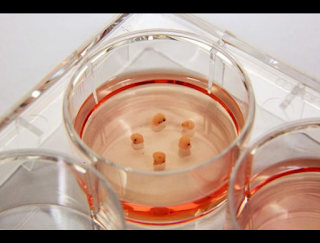What are Organoids?
Organoids are groups of cells grown in laboratories that have organized themselves into cellular structures similar to those found in different organs.
The name “organoids” actually means, “organ-like”. In many cases, the cells and cell structure give organoids abilities that are similar to the organ they resemble.
For example - brain organoids develop layers of actively signaling nerve cells (neuron) an even ‘brain regions’ that are similar to regions of the human brain. Currently, organoids that researchers are making can closely resemble some aspects of organs, however, they are certainly not the same as a fully mature organ.
The brain starts developing since a child develops in the womb. In the first trimester, nerve connections are built that enable the baby to move around in the womb, while in the second trimester, more nerve connections and brain tissue are formed.
In the third trimester, the cerebral cortex starts to take over from the brain stem, preparing the baby's future learning. By the time the baby arrives, they can hear they will know voices around and also see a little. Their brain will then continue to grow and develop for many years.
Our brains develop rapidly taking thousands of development steps that sense us along the “human” path rather than that of say, a chimpanzee.
Now researchers are gaining an unprecedented look at those hidden development stages, a lab-grown object called “brain organoids” that resemble miniature brains the size of apple seeds.
According to the Gray Camp, a stem cell biologist at the university if Basel in Switzerland “A lot of the divergence between humans and chimpanzees really can be traced back very early in brain development,”
Organoids really provide a system that we can use and control and manipulate, and it doesn’t involve any human or animal tissue from individuals.
What researchers studied?
Camp said after six to nine months of development, the neurons start to form connections and exchange electrical signals, although the organoids in the current study weren’t allowed to develop that far.
Brain organoids are not the same as the real developing brain, they lack blood vessels and other types of cells that normally migrate in from other tissue, and they don’t grow more than few millimeters long.

However, past research has shown that many development processes are faithfully re-created.
Organoids give researchers a way to model variant development at many points in time, without having to rely on actual brains from deceased lab animals or humans.
Study findings
In the new study, the researchers grew organoids from human and chimpanzee stem cells, as well as from stem cells from monkeys called Macaques. At various points between five days and four months, they took a subset of the organoids, separated the cells and examined which genes were active, they also looked at how the DNA was coiled for clues about how gene activity was being regulated.
The most striking finding was how much later the human organoids reached development milestones.
According to the researchers “The human organoids tend to develop a bit slower than the chimpanzee, and especially the macaque,” the amount of time that it takes the neurons to mature has changed during evolution.
The researchers also found many differences in gene activity between humans and our primate relatives at different stages of development. At present, it's hard to know what those differences mean, but Camp and his colleagues have a plan for finding out. They want to swap out key pieces of DNA in human and nonhuman organoids, inserting a bit of human DNA into chimpanzee stem cells and a bit of chimpanzee DNA into human stem cells, for example. By studying how a swapped DNA sequence alters organoids growth, researchers should be able to pinpoint exactly how that stretch of DNA helps make us human.
Past studies using real tissues have also found that humans have slower brain development than other species, said Camp. The new findings show that organoids can be used to study such timing differences.
Conclusion
Researchers believe organoids are the next generation of biological tools for research, drug discoveries, disease, and disorders. Recently evolve traits tend to be more prone to dysfunction since evolution hasn’t had time to work out all the kinks.
For example – back pain and birth complications are thought to be related to our species' relatively recent habit of walking upright.
There is no change that has been more dramatic in human evolution than the expansion of our brains studying how that unique expansion happens could reveal why it sometimes goes wrong.
Researchers – Alex pollen and Gray camp
Co-led with Barbara Treutlein
Source – The journal nature
















No comments:
Post a Comment